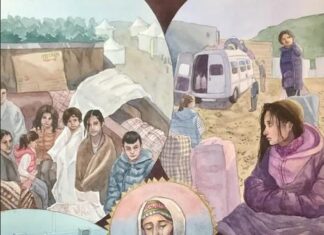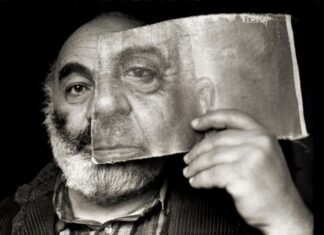By Aram Arkun
Mirror-Spectator Staff
NEW YORK — Armenians seem almost obsessed with fate — jagadakir. You might think that it is because of all the painful vagaries of modern Armenian history, but in fact, it is something that many people think about, whether religious or not. Anaïs Alexandra Tekerian and Kevork Mourad thought about it too, and prepared a multimedia presentation called “Tangled Yarn,” which premiered on August 15 in New York City and has the last of five performances on August 26. The production is part of the New York International Fringe Festival (FringeNYC), which claims that it is the largest multi-arts festival in North America. More than 200 companies from all over the world perform for 16 days in more than 20 venues.
What is unusual about this performance is that with the use of modern technology, it combines live drawing, music and acting. Mourad illustrates the story and draws the paths it must take, with a computer and projector. He served as director and planned the staging. Tekerian, the author of the text or story, is the sole actress, alternating between the characters of the two grandmothers and Ismene. Tekerian also composed nearly all the music for the performance together with her fellow members of a cappella trio, Zulal. The music was nearly all prerecorded.
“Tangled Yarn” is the story of three generations of women. The main character’s name is Ismene. When you learn that Ismene’s sister is Antigone, you can already surmise that this performance is based on stories from Classical Greece. Ismene and Antigone are daughters of Oedipus. In the plays of Sophocles, Antigone is sentenced to death for defying the order of King Creon of Thebes (her uncle and greatuncle) against burying Polynices, her brother. Ismene initially refuses to help Antigone, despite the traditional importance of burial, because she understands that opposing the government would be futile and dangerous. Nonetheless, when Antigone is sentenced to death, Ismene declares she is as guilty as her sister. In the end, King Creon does not execute her because he understands she did not really break the law, but Sophocles does not write about her ultimate fate.
Despite all this Greek background, the two grandmothers of Tekerian’s Ismene are Armenian and Latvian, and the story is transposed to the present. In fact, the grandmothers are largely based on Tekerian’s real-life grandmothers.
Tekerian slips quickly into the character of Ismene, helping her mother prepare the wedding dress for Antigone. Then she adopts an Armenian accent to become the grandmother Verzhin, and the audience learns of her arranged marriage as a child of Genocide survivors living in Ethiopia. Switching back to Ismene, she next becomes the grandmother with a Latvian accent. This grandmother attempted suicide at 18, and fled Latvia for Germany during World War I. There, after working in a clock factory, she was placed in a labor camp. And the performance continues, with the character of Ismene always serving as an intermediary stop between the two grandmothers.









